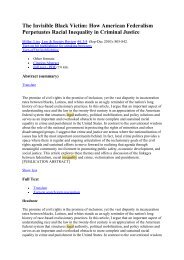Ski – resort and regional development: profile of visitors ... - E-Journal
Ski – resort and regional development: profile of visitors ... - E-Journal
Ski – resort and regional development: profile of visitors ... - E-Journal
You also want an ePaper? Increase the reach of your titles
YUMPU automatically turns print PDFs into web optimized ePapers that Google loves.
Measuring destination competitiveness: an exploratory study <strong>of</strong> the canaries, mainl<strong>and</strong> spain, france, the balearics <strong>and</strong> italy<br />
the tourist industry in different countries around the world. Based on a database drawn up<br />
annually by the World Travel <strong>and</strong> Tourism Council (henceforth the WTTC), the TCM attempts<br />
to overcome one <strong>of</strong> the main shortcomings <strong>of</strong> the Calgary Model.<br />
The index is calculated for over two hundred countries <strong>and</strong>, with this information, the countries<br />
are ranked according to their level <strong>of</strong> tourism competitiveness. The results show that the most<br />
competitive countries, in terms <strong>of</strong> tourism, are the United States, Sweden, Norway, Finl<strong>and</strong><br />
<strong>and</strong> Australia in that order. At the other end <strong>of</strong> the scale are Burkina Faso, Chad, Benin,<br />
Ethiopia <strong>and</strong> Cambodia.<br />
With Gooroochurn <strong>and</strong> Sugiyarto’s proposed monitor (2005), many countries can be compared,<br />
given the type <strong>of</strong> variables that it uses. The main problem, however, is the results that it gives.<br />
Except for the USA, none <strong>of</strong> the other top countries in the tourism competitiveness ranks are<br />
among the most commonly visited countries in the world. Indeed, these supposed other leaders<br />
do not receive very high visitor numbers (2.5% <strong>of</strong> the world total) 2 . At the same time, it also<br />
has other shortcomings: i) It lumps together totally different types <strong>of</strong> destinations, even though<br />
intuitively it can be assumed that the factors that make the Bahamas (a sun <strong>and</strong> s<strong>and</strong> destination)<br />
competitive as a tourist destination will not be the same as those <strong>of</strong> Switzerl<strong>and</strong> (a mountain<br />
destination), since they <strong>of</strong>fer very different tourism products; ii) The monitor lends too much<br />
importance to variables like technology (the amount <strong>of</strong> high-technology that is exported,<br />
number <strong>of</strong> mobile telephones etc.) <strong>and</strong> gives the environment a very secondary role, when<br />
in literature natural resources are cited as one <strong>of</strong> the main attractions <strong>of</strong> a destination (Crouch<br />
<strong>and</strong> Ritchie, 1999; Mihalic, 2000; Butler, 1980, Jennings, 2004, among many others).<br />
2.1.3 Dwyer <strong>and</strong> Kim’s Destination Competitiveness Indicators (2003)<br />
Taking a similar approach to that initiated by Crouch <strong>and</strong> Ritchie (1999), Dwyer <strong>and</strong> Kim’s<br />
Destination Competitiveness Indicators (DCI) (2003) explore a series <strong>of</strong> factors that are<br />
considered to determine destination competitiveness. The authors propose a number <strong>of</strong><br />
indicators for measuring competitiveness. Among the different factors that determine<br />
competitiveness, they cite the available resources (natural resources, cultural assets <strong>and</strong> heritage<br />
items), created resources (tourism infrastructure, the activities on <strong>of</strong>fer etc.), supporting factors<br />
(infrastructure in general, the quality <strong>of</strong> service, access to the destination etc.) <strong>and</strong> destination<br />
management factors.<br />
The main drawback to this proposal is the difficulty involved in applying it. It would no doubt<br />
be very useful to identify the situation <strong>of</strong> each <strong>of</strong> the said determinants using indicators or<br />
surveys, but it would be costly <strong>and</strong>, in some cases, impossible, given the lack <strong>of</strong> available<br />
<strong>and</strong>/or comparative data for destinations. At the same time, the authors also point out that a<br />
better insight into tourist motivations <strong>and</strong> their typologies is needed if the factors that determine<br />
competitiveness are to be properly identified <strong>and</strong> weighted. Under no circumstances should<br />
the aforementioned factors be considered to have the same influence on a destination’s<br />
competitive capacity.<br />
Tourism Today - Fall 2007 - Full Paper<br />
63














